The four P’s of service management in the last version has been replaced with the ITIL four dimensions of service management. They are;
- Organization and People
- Information and Technology
- Partners and Suppliers
- Value Streams and Processes
Each dimension focuses on a different perspective that’s important to delivering value to customers and other stakeholders.
When designing a service, we can ensure that nothing has been overlooked by considering all four dimensions.
The four dimensions represent four key perspectives essential to providing value to customers.
To put it another way, the four dimensions support a holistic approach to service management.
For example, the implementation of a new COTS application requires a holistic approach. It could be a bleeding-edge business solution; however, the failure to consider the necessary technology infrastructure and in-house technical expertise to integrate it with existing software applications could lead to disastrous results.
Introducing an application to fix a significant business problem without considering its impact on the people, partners, and technology is doomed to fail.
Let’s take a closer look at these dimensions and how they contribute to creating value for customers and the organization through products and services.
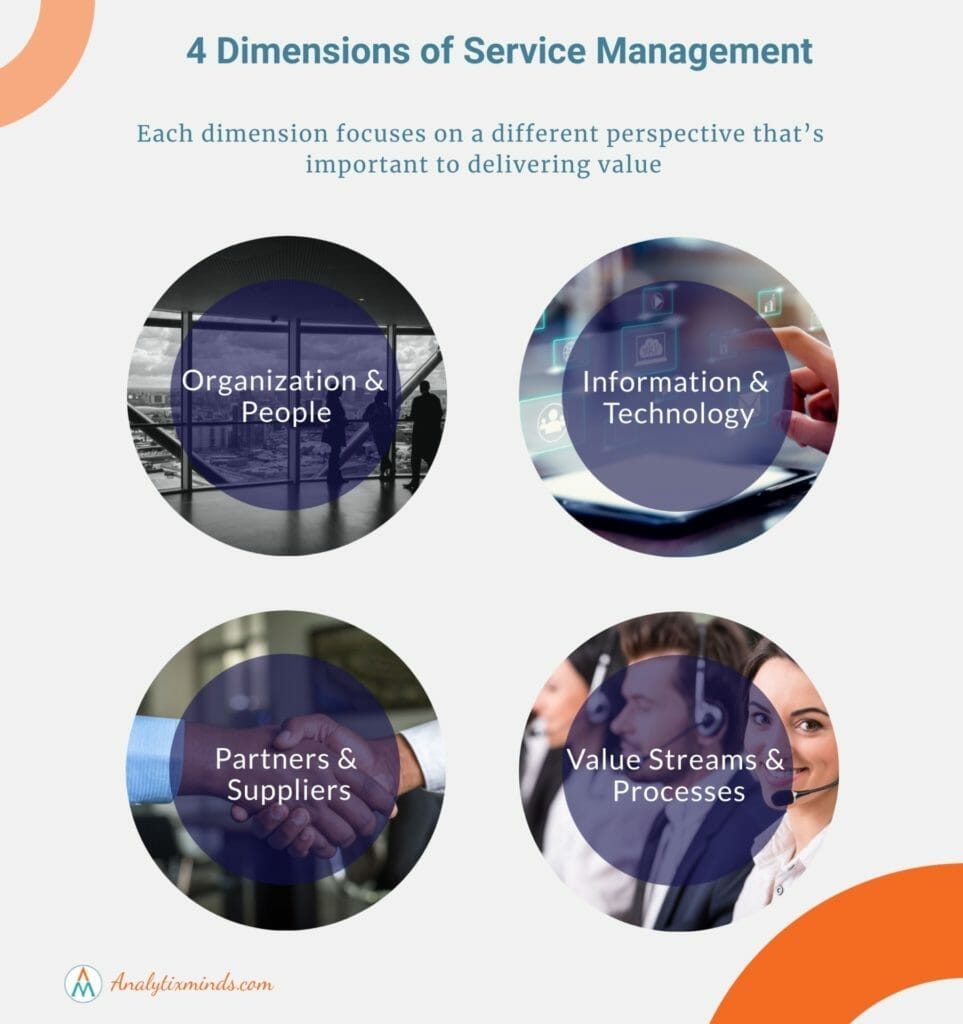
Organizations and people
First, you’ve got the whole service organization and the people. Organizations come in various structures and sizes. As organizations get bigger, it’s important to set up a formal structure, responsibilities, and roles to support the overall strategy and operations.
In order for a business to grow, there needs to be a formal structure in place. Setting up roles helps each person understand their responsibility, which leads them to achieve what’s expected from them daily.
People include anyone involved in creating and consuming services, such as employees, managers, executives, customers, employees of the service provider,
people involved in the creation and consumption of services are quite varied, including employees, managers, executives, customers and other stakeholders.
The organization and people dimension covers much familiar ground, and the most noteworthy components are;
- Organizational structure
- Culture
- Roles and responsibilities
- Talents and skills of the workforce
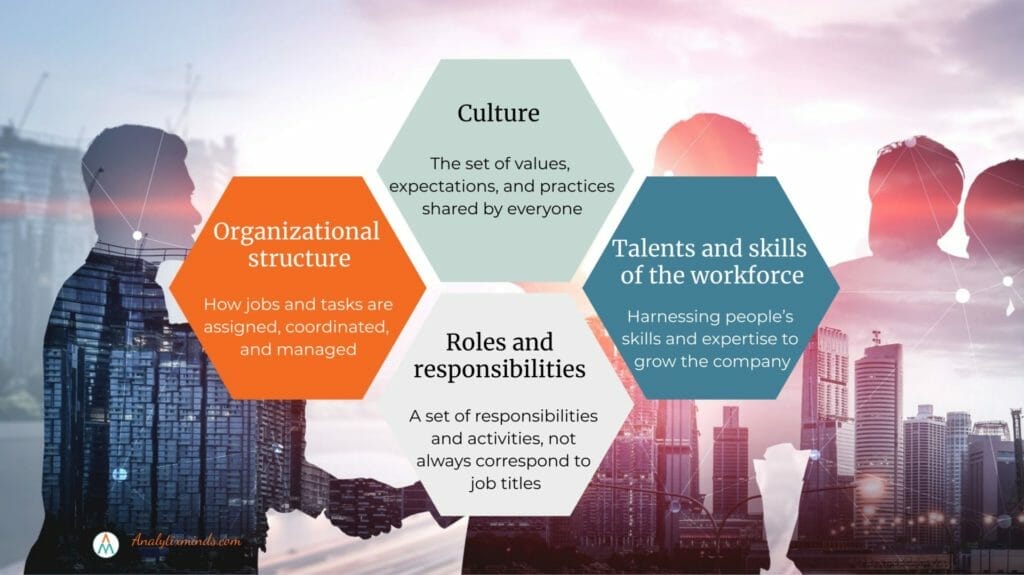
Organization Culture
The way people do things inside an organization
Organizations are often thought of as machines, with every cog in the system contributing to some final result.
But what about culture?
Strong organizational culture is the hallmark of successful companies; it sets the tone for everything an organization does. A great corporate culture is a positive reflection of the company’s values. It leads to employee engagement and improved business results.
So, what is organizational culture?
Organizational culture is the set of values, expectations, and practices shared by everyone in the organization. It lays out how people within the organization should behave. Building and sustaining the culture requires both strategy and structure while, most importantly, staying consistent and authentic. ITIL suggests you can start by adopting the Seven Guiding Principles for a healthy culture.
Organizational culture is the set of values, expectations, and practices that everyone in an organization shares. It defines how people should behave within your company. It is something you can work on continuously to make the lives of employees better! ITIL suggests adopting Seven Guiding Principles is the key to building and sustaining healthy organizational cultures.
Zappos, for example, is known for its unique organizational culture. They only hire people who are committed to the company’s vision. New employees are trained on the company’s ten core values from the outset. Zappos’ employees learn how to respond to customer needs by handling phones in the call center for their first few weeks on the job.
You have to undergo four weeks of call center training regardless of whether you’re in senior management or on the front line. It is said that by the end of the first week, you will be paid and let go if you’re not at ease with their corporate culture.
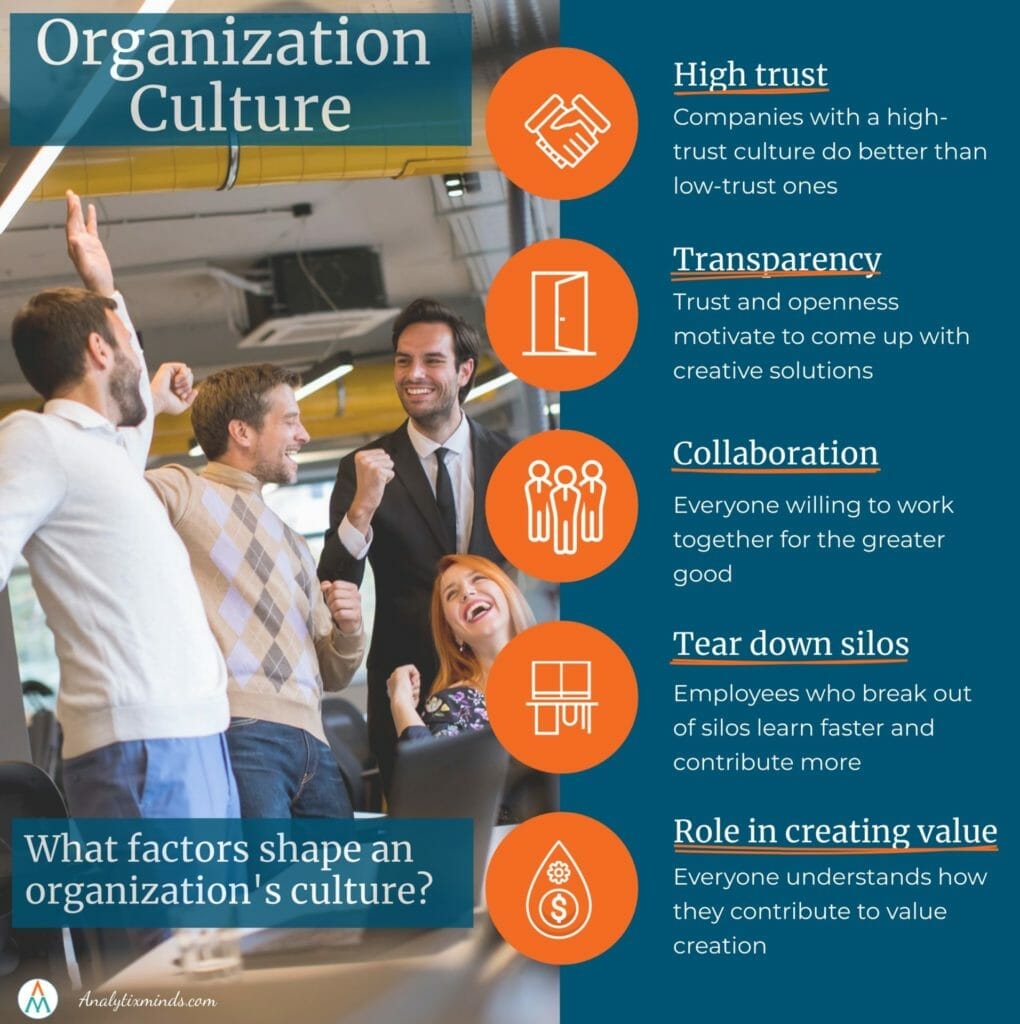
What factors shape an organization’s culture?
High trust
Leaders are responsible for shaping an organization’s culture. The culture of the company can be seen by how the CEO handles crises. So it makes sense that companies with a high-trust culture do better than low-trust ones.
Transparency
Trust and openness motivate people to come up with creative solutions. Innovation is hard without strong leadership. It’s easier for people to come up with creative solutions when an organization is open and transparent.
Collaboration and shared values
Employee experience and engagement are shaped by these values. We’re more committed to a common goal when we work together. Employees who feel part of a positive culture are more likely to enjoy their jobs and provide an excellent customer experience.
Collaboration is key to getting the best results. When collaboration is part of an organization’s culture, everyone’s always willing to work together for the greater good.
Tear down silos
Employees who break out of their silos learn more and contribute more to the company. A great way to break down silos is to build relationships across multiple teams, departments, or sections. Leaders should also let their employees learn about different parts of the business.
Help employees understand their role in creating value
Most employees don’t see the connection between their work and the company’s bottom line. Lack of big-picture understanding can hurt employee engagement. Organizations can foster collaboration and cross-silo communication by showing each role a direct connection between their contributions and value creation.
Organizational Structure
An organization’s structure is how jobs and tasks are assigned, coordinated, and managed. It tells employees what to do, who relies on it, and how to report progress. Every organization’s business and strategy is built on its structure.
- An organization’s structure comprises of four things: centralization, formalization, hierarchical levels, and compartmentalization.
- Centralization measures how much power higher-ups have. A high degree of centralization means decisions are made at the top.
- Formalization is how much an organization relies on written policies and procedures to do its daily business.
- Hierarchy is the number of levels in an organization. For example, structures can be tall and have many layers or flat and have just a few.
The departmentalized organization is broken down into functional teams (like marketing, procurement, manufacturing, etc.) or departments (like services, products, customers, etc.).
An organization’s type depends on its operations and human capital management philosophy. But, of course, there’s no perfect organizational structure, only ones that align with the organization’s goals.
Here are some examples of these types of structures.
Functional Organization
A functional organization lets functional experts take charge. It can boost operational efficiency because the decision-makers have specialized skills and experience.
There might be groups like purchasing, inventory control, production planning, warehouses, customer service, etc., all headed by experts in that area.
Divisional Organization
A divisional structure organizes each organizational function by product or region. Each division has everything it needs to support its geography or product line. For instance, each division has its own purchasing, inventory control, IT, and marketing teams.
Project Organization
Project organizations are only formed for the duration of the project. Every project has its own team of experts and workers. Usually, they report to a project manager.
Matrix Organization
Matrix structures combine functional and project structures. It’s not like a traditional hierarchical structure. This structure can handle both functional and product-based reporting.
Line Organization
There are multiple levels of management, then there are operational levels, so authority goes down the whole hierarchy.
Flat Organization
In flat organizations, the structure is lean, with no middle managers or very few. Small companies and startups usually have flatter structures since there’s no need for hierarchy.
How do different structures impact you?
Bringing new ideas to fruition is hard with a formal, centralised management structure since they have to go up the corporate ladder and get watered down or rejected.
IT Service Management roles and responsibilities
What is a role? A role is a set of responsibilities and activities. A person or group can have multiple roles. Roles don’t necessarily correspond to job titles.
Multiple roles are carried out by one person in a smaller company. In larger companies, roles are more segregated and specialized. The RACI model is often used to define roles and responsibilities.
- R – Responsible: Person or group responsible for doing the work.
- A – Accountable: Person who owns the end result. Accountability is always assigned to a single person.
- C – Consulted: People whose opinions are sought out.
- I – Informed: People who are kept in the loop to receive information.
Talents and skills of the workforce
A business’s success depends on having the right people with the right skills and knowledge. Talent can be defined in different ways, but it generally refers to employees with special skills and abilities.
Workforce management is about hiring the right people for each position and ensuring there are enough resources to meet the organization’s current and future needs.
Talent management is about harnessing people’s skills and expertise to grow the company while helping them learn and grow.
Information and Technology
Information is one of the biggest assets of the digital age. The term “digital transformation” is thrown around a lot to describe how IT has influenced businesses.
In general, technology has made every organization more efficient and effective. There are a couple of ways information and technology are used in service management.
- Information necessary to create, manage, consume services
- The technology required to support and enable services
IT helps people deliver services more effectively than ever. It’s not just a way to better support customers; it’s what drives the services. IT Services are created, delivered, consumed, and managed using technology.
It includes the infrastructure for running the business software. It also involves things like hardware, software, systems, networks, databases, storage, desktops, applications, services, applications, virtual servers, storage, data centers, disaster recovery, etc.
For example, an organization that runs an online business requires IT resources such as,
- Web platform
- Email service
- Cloud computing
- Hardware
- Networks
- Storage Databases
- Data centers
Technology that supports ITSM includes:
- Workflow management systems
- Communication and collaboration systems
- Inventory management systems
- Data Aanalytics tools
- Machine learning
- Mobile platforms
- SAAS applications
- Knowledge bases
Considerations for Information
Focus on providing value
Information management is necessary for a company to create value for customers. So, it’s important to make sure that the information is available and can be retrieved and used effectively and efficiently.
Information management is necessary for a company to create value for customers. So, it’s important to make sure that the information is available and can be retrieved and used effectively and efficiently.
Identify how information is exchanged
Aside from availability, it is crucial that the processes are reliable, and the data is accurate and relevant. Each intermediate process and application should have access to the same data.
Identify types of information needed for services
Service providers should identify what kind of information they need to provide services. Also, why do they need the information?
Service providers should only receive information from service management that they actually need. Service management information can be wide ranging. You should avoid collecting a lot of information even if it seems tempting. Too much information can be challenging to manage.
Comply with information security and regulatory requirements
You must adhere to information security requirements and secure your customers’ data. Regulation compliance, such as the new GDPR (General Data Protection Regulation) passed in the EU, is another aspect of managing information. Users can choose where their personal information is used.
How information should be handled also varies depending on the geography and industry. Therefore, all those regulations must be taken into account during the design and development stages, as one has to make sure they don’t lose sight of what they set out to do.
Technology considerations
Compatibility of new technology with the existing infrastructure
Nowadays, it’s almost impossible to run a business without using technology in some form. When it comes to implementing new technology, businesses often have to consider if it is compatible with the current technology that is in place.
When you are implementing new technology, make sure it is compatible with your existing technology. It should be easy enough to integrate without disruptions to the business.
An excellent example of this would be a new software application that is not compatible with existing hardware. This can disrupt your business if not addressed at the design stage.
Impact of technology disruption
Organizations are leveraging technological advances to grow globally. However, technology disruption has forced many organizations to develop new business models. It is a common phenomenon nowadays.
There are many technologies that can disrupt the status quo, including artificial intelligence, machine learning, Internet of Things (IoT), augmented reality, virtual reality, blockchain, big data, etc.
Are there security constraints or regulatory issues with existing technology?
Servers and storage providers must both be reliable and secure. Therefore, security is among the most critical aspects of selecting a technology.
The security of your IT services is directly connected to the security and privacy of the information and data it handles.
Customers’ data can be stolen and compromised if the information is not secure and protected. Therefore, it is crucial to design and develop technology that is equipped with the most current security features and protocols.
Does technology have longevity?
Has the technology matured enough to be implemented? Is it a bleeding edge? What resources are available for its support?
The technology landscape is constantly changing. New innovations pop up all the time. There are many cases where new technology is released and then replaced within a short period. Often, technology is replaced before it reaches its full potential.
Many times, technology is replaced for reasons other than cost. Technology maturity and the impact it has on the business are also deciding factors.
Will the new technology add more constraints?
Technology can be a double-edged sword. It can significantly increase productivity and efficiency, but it also introduces a new set of constraints.
Every day, we hear about new technology. Disruptive technologies on the horizon include augmented reality, driverless cars, and intelligent chatbots.
Partners and Suppliers
Suppliers and partners come in all shapes and sizes. Only a few organizations can function without external suppliers. Relationships between companies are crucial to success. Many organizations rely on third parties to manage certain aspects of their business.
The scope of the partners and suppliers dimension includes:
- Service provider/service consumer relationships
- An organization’s partner and supplier strategy
- Factors that influence supplier strategies
- Service integration and management (SIAM)
There are different levels of formality in relationships between organizations. It can range from writing a contract outlining responsibilities to agreeing to work towards common goals in a less formal setting.
Supplier strategy considerations
Strategic focus
Some companies may prefer to focus on their core competencies and outsource non-core functions. Others may prefer to keep everything under one roof, retaining complete control over all important functions.
Corporate culture
Traditionally, large organizations have had a very inward-looking corporate culture. The focus was primarily on internal operations, and partners were treated as extensions of the internal organization.
Despite expanding their business and diversifying their operations, many organizations retained this approach.
This approach has become a liability in today’s growing globalized marketplace. Now more than ever, organizations need to think outside the box and be more collaborative.
Resource scarcity
It can be challenging for a service provider to find the needed staff if a skillset is in short supply.
However, it’s important to have employees with the right skills to handle the needs of the business.
Businesses can acquire the human capital they need to stay competitive through outsourcing. As a result, outsourcing has grown in popularity over the years. It can increase the flexibility of a company to handle fluctuating demands and complex tasks.
Cost concerns
In some cases, sourcing a particular requirement from a supplier is more economical than sourcing internally.
Most organizations choose to outsource because of the labour cost. Basically, you can outsource the organization’s functions to some other country where the labour is cheap.
In addition, there are other costs, such as maintenance and utilities. Some countries have low labour costs, but these other costs can be very high.
Subject matter expertise
It’s sometimes safer to use a supplier who has expertise in a particular area. Developing and maintaining subject matter expertise in-house can be expensive. In such situations, they typically outsource the work to a specialized supplier. Sometimes, a company may outsource a particular job to a specialist supplier. In other cases, a company may outsource a particular function, such as payroll processing, to a specialist service provider.
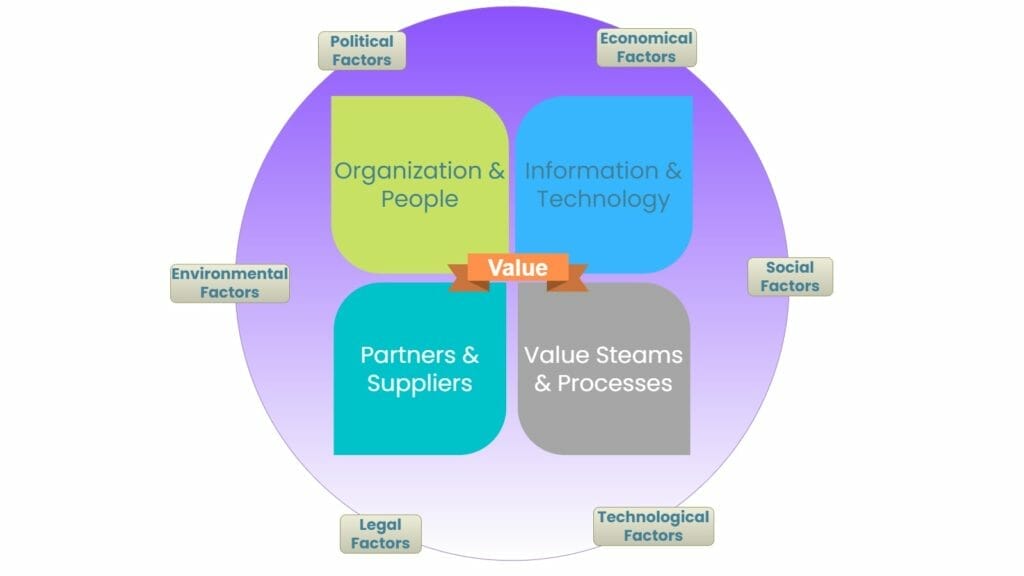
External constraints
Most often, external constraints shape the supplier strategy. Some of these external forces are;
- Government policies
- Industry codes of conduct
- Social factors
- Political issues
- Legal factors
- Economical factors
New tariffs or import restrictions, for instance, may influence supplier strategy. Outsourcing depends heavily on the company’s overall risk profile. A PESTLE analysis is a valuable tool for identifying external constraints in supplier management.
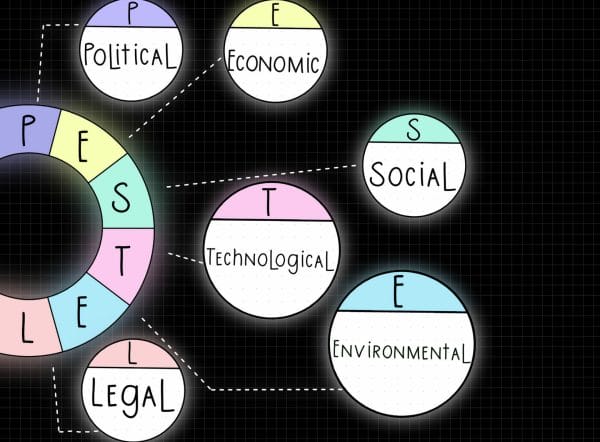
Demand patterns
Many organizations experience high levels of variation in demand for their services. Although this variation can be seasonally based on the time of year, demand patterns may also vary due to the day of the week or even the time of day.
Organizations may use external service providers to deal with variable demand depending on these patterns. It provides the benefit of being flexible and agile in the face of changing demand.
Value streams and processes
You can think of a value stream as a series of steps your organization takes to create and deliver products and services. These are basically process flow charts, with waiting times between steps.
With value streams, an organization is able to see clearly what it delivers and continuously improve what it does. So, the key to improving performance is identifying and understanding its various value streams.
Organizations should look at how they do their work and map all the value streams they can find. This way, they can analyze their current state and identify any barriers to workflow and non-value-adding activities. Eliminate wasteful activities to boost productivity.
Add more value-added activities to the service value chain. This can be new activities or changes to existing ones that will make the organization more productive. For example, value stream optimization can involve automation or adopting new technologies to gain efficiencies or improve user experience.
Value streams should be defined for each product and service. Value streams can be reshaped depending on the business strategy. Sometimes these can stay stable for a long time. However, value streams need to be constantly improved to make sure they are optimal.
What is a process? An interconnected or interacting set of activities. A process takes inputs and turns them into outputs.
What is value stream mapping? A value stream map helps identify where the actual value is added. This allows you to improve the overall efficiency of a service or product.
